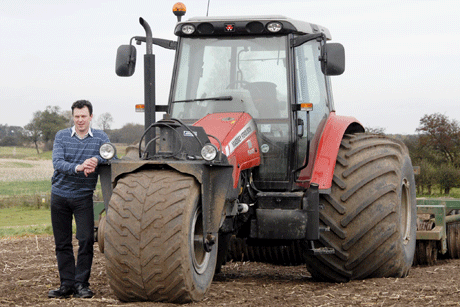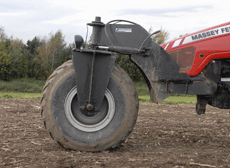Three-wheel tractor conversion treads carefully

Back in the early 1990s, the Atkinson family modified an MF690 to run on three wheels instead of four. Fifteen years later, it was time for an upgrade.
The heavy clay soil at Manor Farm near Stillingfleet, Yorkshire, has to be treated carefully. It needs low-ground-pressure kit when it’s wet and enough weight to consolidate clods when it’s dry, says James Atkinson. In 1993, with a set of Terra tires in the shed and having seen three-wheeled tractors coming out of Holland more than a decade before, he decided to modify the farm’s drilling tractor to cover nearly all of the 3m (10ft) drill width.
“This is where the MF690 came into its own,” he says. “A tractor pass was cultivation in itself – it crushed the clods, but was light enough not to do any damage.”
The Atkinsons intended to take off the modification and bolt the normal wheels back on when they had completed top work. “But that never happened,” says father Norman. “It was always in use and would do anything any tractor in its class would.”
But after all-year-round use for 15 years, the 690 had reached the end of its natural life, says James. “And, as I was away in the forces, we had no replacement. Dad said if the three-wheeler went, so would he.”

So, last March, when James’s career as an aircraft engineer in the Royal Navy was completed, he took on the challenge of finding a suitable replacement tractor.
The family scoured the second-hand market for a light 90hp machine, and found a 2WD Massey Ferguson 5545 fitted the bill. “And because it’s turbocharged, we could tweak it up to over 100hp if we needed to,” adds James.
The conversion involved removing everything from the Massey’s front axle. The casings were kept for when the Atkinsons come to sell the tractor, at which point it should be just a case of bolting the unit back on.
“I would be very surprised if the buyer would notice any difference,” says James, who now runs specialist agricultural engineering company Atkinson Systems.
Once the front axle was taken off the MF5445, the nose was jacked up so the old axle from the 690 could be rolled up to it to see what modifications were needed.
“From there, we looked at what could be used from the old conversion, what we could use again and what alterations had to be made,” says James.
The only thing affected mechanically is the steering, he adds. The previous model used oil from the original hydraulic circuit, so it had just been a case of finding the right-sized hydraulic rams for the job.
“We looked at the capacity of the hydrostatic steering cylinder and made certain we could match that, as we didn’t want too few or too many turns, or a different lock.”
It turned out that the existing cylinders were bang on, so this time it was a lot easier. The two original 75mm rams, complete with beefier bearings, just slotted into place.
One thing the new conversion allowed James to do was sort out niggling problems they had noticed with everyday use of the 690. “Because the 690 had a tendency not to grip as it should on full lock, I decided to alter the angle of the king pin and main pivot to give the tractor more positive steering,” says James.
With these modifications to the steering geometry, he reckons the steering is comparable to other tractors in its class, with a lock better than its four-wheel drive equivalent.
The radiator grille, which had to be sacrificed last time, now fits snugly where it should and panels attach in exactly the same way, sealing round the radiator in the same fashion. This also allows normal access to the radiator and water levels.
“The only thing we’ve had to compromise on is access to the air filter. But we only have to unbolt the housing to get at it and that’s a fairly easy task,” he says.
Once the design changes were finalised, the original fabrication was overhauled, threads were recut on the stub axles to accommodate new tapered roller bearings on the front axle, and the new set-up was rolled up to the front of the tractor for final changes. When it came to the the kingpin, the original bearings were kept and the dust seal arrangement improved.

The wheelbase is about 200mm (8in) longer on the new model, so once things were welded up enough to take the tractor’s weight, the Atkinsons took the 5445 for a spin to check lock and manoeuvrability. Once that was complete, they welded it up solidly.
Although James reckons he spent seven to eight days on the alterations, the cost of the modifications came to little more than £500. Tapered bearings amounted to £80 and bronze bushes and hardened steel bar to make up the new steering pins were less than £100. And the 15mm plating, which they had in the shed anyway, was bought before steel prices rocketed at about £200.
“We even managed to use the same lamp holders, albeit with the lens out of the new grille, so that the lights still turn with the steering wheel,” he says.
The new three-wheeler is nearly always in use, says father Norman Atkinson. “It does everything any other tractor in its class would do, only with a lighter touch.”
The Massey is used for power harrowing, rolling and other top work and is ideal for spring grassland work, too.
Ride stability is good both in the field and on road, with the slightly longer wheelbase helping, says James. “I would go as far as to say it’s more stable on the road – you don’t get the characteristic wandering you do with a four-wheeled tractor.”
Looking to the future, James would like to try his hand at adapting a 150-180hp tractor to run on three wheels. “A slightly bigger tractor capable of pulling a newer 4m trailed drill would be the next step,” he says.
“It’s a unique machine and I would be surprised if any company looked at doing it commercially. Few would appreciate the benefits without having had one, but to us they are very tangible.”
Benefits of the three-wheeler
- Spreads weight of tractor evenly
- Fewer wheel marks
- Great for areas that need a light touch

